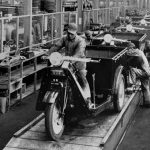On October 7, 1913, inspired by the slaughterhouses in Chicago and Cincinnati, Ford engineers successfully created a conveyor system to move the Model T frame on the floor of a factory in Highland Park, Michigan, to increase the speed of car assembly.
> 2 Advanced Technologies on Future Ford Cars
This groundbreaking innovation helped Ford significantly reduce the cost and time required to assemble a car, opening the doors for future production growth and market expansion. By early 1914, Ford incorporated this mobile assembly line into its production model at its first factory, marking the beginning of a 100-year journey of innovation and reorganization that continues to this day.
This mobile assembly line, located at Ford’s Highland Park plant in Michigan, simplified the Model T production process from over 3,000 parts to just 84 steps, which could be efficiently completed by a team of skilled workers.
On October 7, 1913, Ford engineers set up a relatively primitive mobile assembly line at the Highland Park plant. The system consisted of a winch and a rope stretched across the floor. On that historic day, 140 assembly workers stood along a 150-foot-long line and witnessed the world’s first-ever mobile assembly line model.
Thanks to the new assembly process, the labor time for workers was reduced from over 12 hours to approximately 3 hours. By 1916, the number of Model Ts produced had skyrocketed to 585,388 units, while the selling price dropped to $360.
The first AA truck rolled off the assembly line at the Dagenham plant in England in 1931.
In 1927, Model Ts were being assembled at the Trafford Park plant in England in less than 24 seconds. By then, the number of Ford Model Ts sold worldwide had reached 15 million, accounting for half of all cars sold on the market.






(To Be Continued…)
Phan Lien (TTTÐ)
Ford Ranger 2022 Unveiled: Continuing to Dominate the Throne
The all-new Ford Ranger Generation has officially launched at the Ford factory in Hai Duong today (26/8). As a smart, versatile, and best-performing Ranger to date, the New Generation Ranger promises to continue the legacy of over 20 years in Vietnam and break all boundaries for an inspiring lifestyle.




















































